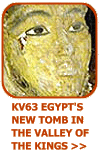|
|
|

Pharaoh profiles: Akhenaten | Alexander the Great | Cleopatra VII | Hatshepsut | Ramesses the Great | Tutankhamun | Tuthmosis III
To the Ancient Egyptians, the name was an essential element of each and every human individual.
|
The name was regarded as a living part of each human being. A child had to be named immediately at birth, otherwise it was believed that he or she would not properly come into existence. The symbolic importance of the name also meant that its removal from monuments or statuary would erase the memory and existence of that person.
|
|
Just like today, personal names often followed a fashion where individuals were named after a particular deity that either happened to be pre-eminent at that period, or was perhaps of local importance. Some names are simple, such as Neferet, meaning "beautiful woman" whilst others form statements, such as in Rehotep, meaning "Re is satisfied".
|
Egyptian rulers had a unique combination of five royal names.
From the time of the Middle Kingdom, a pharaoh would enjoy five different royal names. The first name would be pharaoh's actual birth name, but the other four would be bestowed upon him when he succeeded the throne. Most of the names that we use for pharaohs today are their birth names. On our dedicated PHARAOH pages, we also include each individual pharaoh's throne name.
The sequence of the five royal names was as follows:
| Name |
Accompanying Title |
| Horus name |
Horus |
| Nebti or Two Ladies |
He of the Two Ladies (Wadjet and Nekhbet) |
| Golden Horus |
Golden Horus |
| Throne name or prenomen |
He of the Sedge and the Bee (king of Upper and Lower Egypt) |
| Birth name or nomen |
Son of Re |
So for instance, Tutankhamun's royal names would be as follows:
| Horus name |
Ka-nakht tut-mesut "Strong bull, fitting from created forms" |
| Nebti or Two Ladies |
Nefer-hepu segereh-tawy sehetep-netjeru nebu "Dynamic of laws, who calms the Two Lands, who propitiates all the gods" |
| Golden Horus |
Wetjes-khau sehetep-netjeru "Who displays the regalia, who propitiates all the gods" |
| Throne name or prenomen |
Nesu-bity Nebkheperu-re "King of Upper and Lower Egypt, Lord of the manifestations of Re" |
| Birth name or nomen |
Tut-ankh-aten "Living image of Aten". |
Tutankhamun later changed his original birth name to his more commonly known adopted name: Sa-re Tutankhamun (heqa-iunu-shema) "Son of Re, living image of Amun, (ruler of Upper Egyptian Heliopolis)"
Back in the days of antiquity
|
Before the 4th Dynasty, the pharaoh was usually known simply by his Horus Name. The name would be written in a "serekh" panel, with the Horus falcon standing on top. The first known "serekh" appears on the Narmer Palette, which represents the beginning of Ancient Egyptian history.
|
|
Occasionally in the early dynasties, the king might have secondary titles. The "Nebti" sign of the "Two Ladies" is used in the 1st Dynasty by Hor-Aha, but not as a part of his royal titles. In fact it wasn't until the 12th Dynasty that the "Nebti" title became a standard element of the royal name sequence.
|
Introducing the Cartouche
 The Cartouche is a representation of an oval loop of rope which is tied at the ends. Inside the oval loop are the hieroglyphs which form the pharaoh's royal names. Snefru, builder of the Bent and Red pyramids at Dahshur, was the first to introduce the cartouche in the 4th Dynasty. The cartouche subsequently replaced the serekh, or Horus name in identifying the king. During the 5th Dynasty, Neferirkare introduced a second cartouche: the first cartouche contained his throne name, given to him upon his accession to the throne, and the second contained his birth name. The Cartouche is a representation of an oval loop of rope which is tied at the ends. Inside the oval loop are the hieroglyphs which form the pharaoh's royal names. Snefru, builder of the Bent and Red pyramids at Dahshur, was the first to introduce the cartouche in the 4th Dynasty. The cartouche subsequently replaced the serekh, or Horus name in identifying the king. During the 5th Dynasty, Neferirkare introduced a second cartouche: the first cartouche contained his throne name, given to him upon his accession to the throne, and the second contained his birth name.
Although the five royal names and titles were a necessary requirement for the king, they are rarely portrayed together except during the coronation of the pharaoh. The names most frequently used are the Horus name, throne name and the birth name.
Back to the previous page >>
|
|
|








